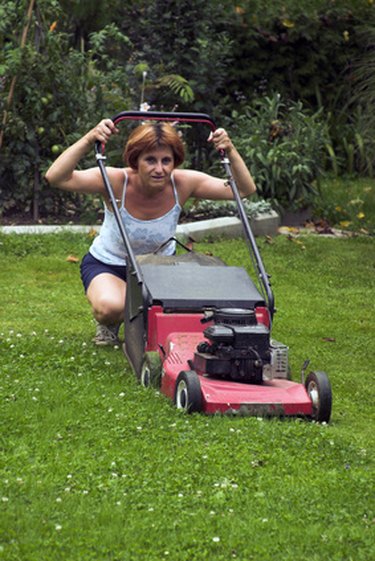
Briggs & Stratton is a small-engine manufacturer whose engines are commonly found in lawn and garden equipment, such as lawn mowers, snow blowers, rototillers and more. These Briggs & Stratton engines utilize an adjustable carburetor to create the gasoline and air mixture for the piston to fire. If your engine is running roughly, either at high speed or when in idle, you may need to set a Briggs & Stratton carburetor adjustment to improve the rough-running condition.
Step 1
Turn off the engine and allow it ample time to cool fully.
Video of the Day
Step 2
Loosen the large set screw on top of the air filter with a flathead screwdriver and remove the air filter from the carburetor.
Step 3
Locate the idle adjustment screw on the side of the carburetor. Gently turn the screw clockwise with a flathead screwdriver until the valve touches the seat. Then, back the screw off counterclockwise one-and-a-half turns.
Step 4
Look on the opposite side of the carburetor, for the high-speed adjustment screw -- if your carburetor has one. Gently turn the screw clockwise until the valve touches the seat, then back this screw off one-and-a-half turns as well.
Step 5
Check to see if your engine has a large bowl on the bottom side of the carburetor that houses the float. If so, it will have a single screw on the bottom of the bowl. Turn the screw clockwise until it stops turning, then back it off one-and-a-half turns.
Step 6
Replace the air filter on top of the carburetor and secure it by tightening the screw in the center of the air filter.
Step 7
Start the engine and let it half-throttle for about five minutes to warm up. Then, slowly turn the idle adjustment screw -- which you adjusted in Step 3 -- clockwise until the engine begins to slow. Note the position of the screw and then begin turning the screw counterclockwise. The engine will normalize, then eventually will begin to slow once again. Note the position where it begins to slow a second time and rotate the screw clockwise to a point halfway between the two positions where the engine began to slow. You have now fine-tuned the idle adjustment.
Step 8
Increase the throttle to full speed. Repeat the adjustments you made on the idle screw on the high-speed screw -- on the opposite side of the carburetor from the idle screw.
Step 9
Test the engine under varying workloads. If the engine runs roughly under any conditions, adjust the idle or high-speed screw to fine-tune the adjustments.
Video of the Day